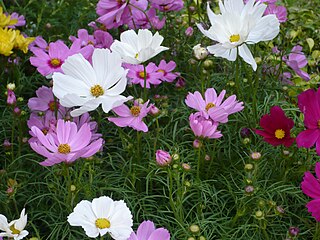
Cosmos is a genus, with the same common name of cosmos, consisting of flowering plants in the sunflower family.

Zygophyllaceae is a family of flowering plants that contains the bean-caper and caltrop. The family includes around 285 species in 22 genera.

Abutilon is a large genus of flowering plants in the mallow family, Malvaceae. It is distributed throughout the tropics and subtropics of the Americas, Africa, Asia, and Australia. General common names include Indian mallow and velvetleaf; ornamental varieties may be known as room maple, parlor maple, or flowering maple. The genus name is an 18th-century Neo-Latin word that came from the Arabic ’abū-ṭīlūn, the name given by Avicenna to this or a similar genus.

The Rhamnaceae are a large family of flowering plants, mostly trees, shrubs, and some vines, commonly called the buckthorn family. Rhamnaceae is included in the order Rosales.

Coursetia is a genus of flowering plants in the pea family, Fabaceae. Members of the genus, commonly known as babybonnets, are shrubs and small trees native to the Southwestern United States, Mexico, the Caribbean, Central America, and South America as far south as Brazil and Peru. The genus is named for French botanist Georges Louis Marie Dumont de Courset (1746–1824).

The Sapotaceae are a family of flowering plants belonging to the order Ericales. The family includes about 800 species of evergreen trees and shrubs in around 65 genera. Their distribution is pantropical.
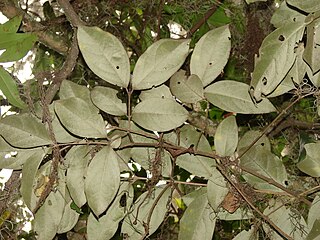
Bunchosia argentea, known as silver peanut butter fruit, is a species of flowering plant in the acerola family, Malpighiaceae, that is native to Venezuela, Colombia, Peru, Brazil, Guyana and Suriname. It produces small orange-red fruits that are sericeous of pleasant taste similar to peanut butter. Leaves have pointed ends and are densely silvery or golden sericeous on the abaxial side.

Nyctaginaceae, the four o'clock family, is a family of around 33 genera and 290 species of flowering plants, widely distributed in tropical and subtropical regions, with a few representatives in temperate regions. The family has a distinctive fruit type called an accessory fruit or anthocarp, and many genera have extremely large pollen grains.
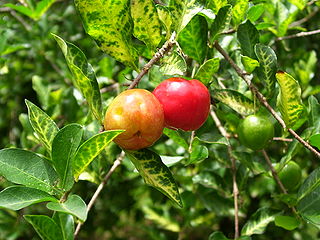
Malpighia is a genus of flowering plants in the nance family, Malpighiaceae. It contains about 45 species of shrubs or small trees, all of which are native to the American tropics. The generic name honours Marcello Malpighi, a 17th-century Italian physician and botanist. The species grow to 1–6 m (3.3–19.7 ft) tall, with a dense, often thorny crown. The leaves are evergreen, simple, 0.5–15 cm (0.20–5.91 in) long, with an entire or serrated margin. The flowers are solitary or in umbels of two to several together, each flower 1–2 cm (0.39–0.79 in) diameter, with five white, pink, red, or purple petals. The fruit is a red, orange, or purple drupe, containing two or three hard seeds. M. emarginata is cultivated for its sweet and juicy fruits, which are very rich in vitamin C.

Malpighiaceae is a family of flowering plants in the order Malpighiales. It comprises about 73 genera and 1315 species, all of which are native to the tropics and subtropics. About 80% of the genera and 90% of the species occur in the New World and the rest in the Old World.
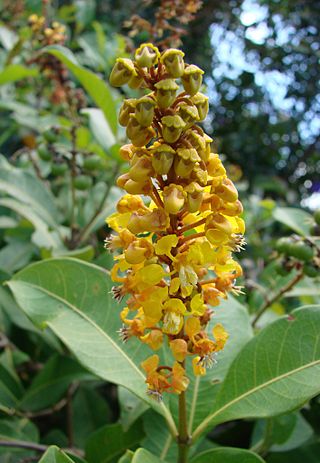
Byrsonima is one of about 75 genera in the Malpighiaceae, a family of flowering plants in the order Malpighiales. In particular in American English, they are known as locustberries. Another widely seen common name is serrets or serrettes.
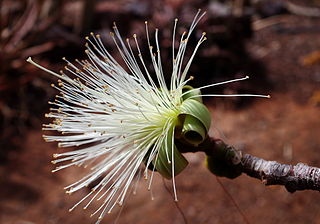
Pseudobombax is a genus of flowering plants in the subfamily Bombacoideae of the family Malvaceae.

Callaeum is a genus in the Malpighiaceae, a family of about 75 genera of flowering plants in the order Malpighiales. Callaeum comprises 11 species of woody vines and shrubs occurring from western Texas to Mexico, Central America, and South America. Two species, C. macropterum and C. septentrionale are cultivated as ornamentals in Arizona and California.

Hibisceae is a tribe of flowering plants in the mallow family Malvaceae, subfamily Malvoideae.
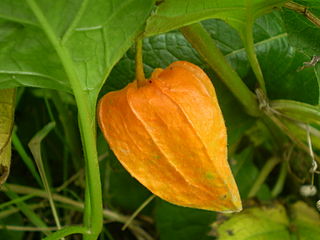
Physaleae is a tribe of flowering plants in the subfamily Solanoideae of the family Solanaceae.

Bunchosia armeniaca is a species in the family Malpighiaceae native to northwestern South America. Common names include cansaboca, ciruela de fraile, guaimaro, indano, and cold-earth mamey. Its Kichwa name is usuma.
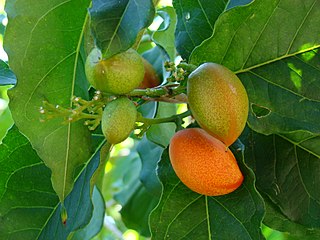
Bunchosia glandulifera, commonly known as peanut butter fruit, is a species of flowering plant in the acerola family, Malpighiaceae, that is native to Central America and South America. It produces small orange-red fruits of sticky and dense pulp, with a flavour and aroma resembling that of peanut butter. It is mostly eaten fresh, but is also used for jellies, jams or preserves. The superficial appearance of the berries are similar to coffee and in Brazil is accordingly called caferana or falso guarana.

Tetrapterys is a genus of flowering plants in the family Malpighiaceae, native to Latin America and the Caribbean, from Mexico through to Argentina, but excluding Chile. Small trees, shrubs or vines, they are known to be toxic to livestock if consumed for long periods of time, and T. mucronata and T. styloptera have hallucinogenic effects in humans similar to ayahuasca.

Gaudichaudia is a genus of flowering plants belonging to the family Malpighiaceae.



















